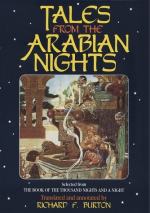[FN#388] Arab. “Tanim” (plur. of Tamimit) = spells, charms, amulets, as those hung to a horse’s neck, the African Greegree and the Heb. Thummim. As was the case with most of these earliest superstitions, the Serpent, the Ark, the Cherubim, the Golden Calf (Apis) and the Levitical Institution, the Children of Israel derived the now mysterious term “Urim” (lights) and “Thummim” (amulets) from Egypt and the Semitic word (Tamimah) still remains to explain the Hebrew. “Thummim,” I may add, is by “general consensus” derived from “Tom” = completeness and is englished “Perfection,” but we can find a better origin near at hand in spoken Arabic.
[FN#389] These verses have already occurred, see my vol. i. p. 275. I have therefore quoted Payne, i. p. 246.
[FN#390] Arab. “Wakil” who, in the case of a grown-up girl, declares her consent to the marriage in the presence of two witnesses and after part payment of the dowry.
[FN#391] Such is the meaning of the Arab. “Thayyib.”
[FN#392] This appears to be the popular belief in Egypt. See vol. iv. 297, which assures us that “no thing poketh and stroketh more strenuously than the Gird” (or hideous Ahyssinian cynocephalus). But it must be based upon popular ignorance: the private parts of the monkey although they erect stiffly, like the priapus of Osiris when swearing upon his Phallus, are not of the girth sufficient to produce that friction which is essential to a woman’s pleasure. I may here allude to the general disappointment in England and America caused by the exhibition of my friend Paul de Chaillu’s Gorillas: he had modestly removed penis and testicles, the latter being somewhat like a bull’s, and his squeamishness caused not a little grumbling and sense of grievance—especially amongst the curious sex.




